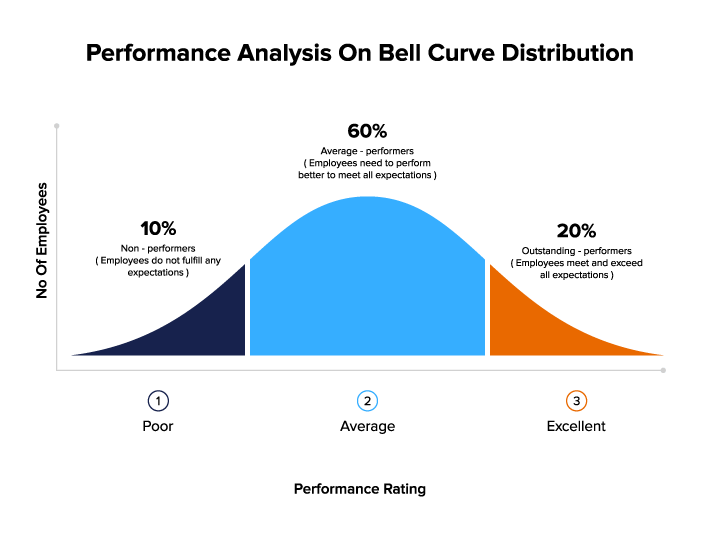Bell Curve
Table of Contents
What is Bell Curve?
The Bell curve is a graphical representation of any data which tends to appear in a bell-like shape. It generally depicts the normal distribution, where the peak represents the mean, median, and mode. They are commonly used to analyze financial and monetary data. But now, in the HR domain, it is also used in performance management.
Relation between bell curve and performance management
Performance assessment using a bell curve demands groups of people to be classified as poor, average, or good. It helps in the analysis of the employees' performance. According to this assessment, even though the employees are good, they are categorized to fit in the bell curve given the need. Such forced rating and skewness in grading may result in being unjust to the individual employees. The below image depicts the performance analysis of the employees on a scale that is 1- Poor, 2- Average, and 3- Excellent.


Frequently Asked Questions about Bell Curve
What does a bell curve show?
With the help of a bell curve, one can generate statistics based on real-world data and collect repeated measurements of any equipment. As for HR, it allows managers to gain insights into employees’ overall performance. The curve can be divided into three parts corresponding to which top, average, and poor performers can be identified. Managers can also select employees eligible for performance appraisals.
Can any company size use the bell curve approach?
A bell curve can be good or bad for organizations and their employees. Primarily, it is more profitable for larger organizations that have 300+ employees and not for smaller ones. Because compared to large, small, and medium enterprises have fewer data, which distorts the result of the curve. A bell curve has its own pros and cons for different companies despite all these.
How is a bell curve beneficial to organizations?
Measuring performance is an essential operation for companies, and implementing a bell curve system can be much helpful. Following are the benefits of it.
Benefits of the bell curve:
- Easy to implement as compared to other measurement methods.
- Helps identify, reward, and thus encourage top performers.
- Helps determine job eligibility for the employees.
- Causes managers to rank appropriately without bias.
- Allows managers to identify training needs for average and poor performers.

People also search for
How is a bell curve harmful to organizational culture?
As much as this method is easy and fast to perform, it carries significant disadvantages too because employees who are not eligible for the process are also considered compulsorily.
Drawbacks of the bell curve:
- The approach is highly rigid and insensitive for employees as in order to meet bell curve needs, managers rate employees considerably and not based on their actual performance.
- As it shows the top, average, and low performers differently, employee morale is affected, and they don’t wish to collaborate and engage in the process.
- As said above, it is not suitable for smaller companies due to fewer data available for calculation.
What is the rule of the bell curve?
Bell curve rule is the rule of 68 95 99.7, which describes an appropriate method for calculations. The rule can be elaborate as follows:
- Around 68% of the data can be found within one standard deviation of mean.
- About 95% of the data can be found within two standard deviations.
- Around 99.7% of the data can be found within three standard deviations.
Why is the bell curve ubiquitous?
Bell curve is widely used due to the below reasons.
- Easy to implement.
- Works in most of the cases.
- A systematic approach to measure performance.
- Most data found are mean values.
- The appraisal process can be done without considerable change to HR software.
Modify your HR and payroll tasks with factoHR today
Let your HR and workforce focus on most important business decisions while factoHR can reduce the burden of daily activities of the organization.

© 2024 Copyright factoHR

